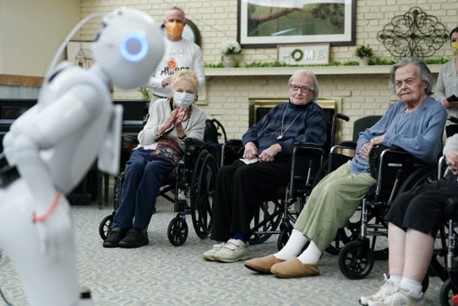By Katie Brenneman

Image Source: RobotLAB
Robots are becoming a more commonplace part of our lives. They can improve the efficiency of various types of repetitive and detail-oriented tasks. One of the spaces they hold great potential for is senior care.
This is a key part of how digital technology is currently transforming healthcare. Advanced tools such as robotics — alongside artificial intelligence (AI), the Internet of Things (IoT), and other applications — are improving the patient experience. They’re driving better care access with telemedical services and even improving accurate decision-making. These benefits are great for everyone, but are particularly vital for vulnerable groups, such as those in senior care.
Robotics in this field is still in its relatively early days. But let’s take a closer look at the emerging trends and how they can make a difference now and in the future.
Medical Assistance Robots
Medical assistance is a key aspect of senior care. As people get older, they can see a decline in various areas of physical and mental well-being. It is essential for care facilities to help care recipients receive medical attention that prevents and treats conditions. Not to mention professionals have to stay on top of changes in needs. While experienced medical staff will be vital for the foreseeable future, robots are already emerging to have a role.
The robotic applications here include:
Medication Delivery
Delivering the right medication is essential for maintaining care recipients’ quality of life. However, staff shortages can make it challenging to keep regular schedules, not to mention that the potential for human error presents risks. Robots, like Servi Plus, are being used to automatically carry medications to patients on time and with minimal staff involvement.
Diagnostic Testing
Given that health challenges change over time, regular testing and efficient diagnosis of conditions are essential for quality senior care. AI software platforms are becoming more commonplace to assist with this. However, some senior care facilities are already starting to trial robotic approaches.
Cruzr — which is effectively a robotic nurse on wheels — is being tested with seniors. It can perform a range of examinations, including capturing temperatures and asking diagnostic questions. Doctors can monitor the test results and connect with patients remotely for more efficient checkups.
Medical robots in senior care are still very new. However, the technology is rapidly improving and there’s significant investment. This means that we can expect to see more robots supporting medical professionals in the near future.
Social Robots
Maintaining strong social ties is vital as people get older. Regular positive interactions help to maintain older adults’ cognitive functioning, with isolation being a potential risk factor for dementia. Not to mention that company can be a mood-booster, fortifying overall mental wellness. However, consistent one-to-one personal interactions are not always practical in senior care and they may not even be preferable for all seniors. One of the emerging solutions here is social robots.
Social robots tend to take a friendly, generally human-like form and are designed to roam around care facilities. Perhaps the most prominent tech in this field is Pepper. This social robot uses AI and other communication tools to interact with seniors. It can sing and dance with residents and have conversations with them. Importantly, the robot can use these social interactions to also run through cognitive exercises with seniors, helping to maintain their day-to-day functioning.
These types of social robots can be a source of enrichment for seniors, but they can also play a role in helping seniors overcome challenges. For instance, many people have difficulty overcoming a fear of seeing the doctor. This can prevent them from getting the timely medical treatment that’s so vital. It can be caused by a variety of factors, including social hurdles such as fear of lifestyle judgment or fear of authority figures.
Alongside other methods for addressing the fear of doctors, social robots can help by using conversational functions to practice interactions with medical professionals. In some instances, they could be a medium for telemedical appointments, rather than seniors having to spend time in anxiety-inducing surroundings.
Cleaning Robots
A clean environment makes a genuine difference to seniors’ quality of life. It promotes health and is just more pleasant to spend time in. However, as people get older, they may find their mobility makes it more challenging to maintain cleaning routines. Care professionals may not always have time to meet the cleanliness standards they would like. This is another area where robots are proving to be effective in senior care.
At the most basic level, seniors can benefit from the increasing accessibility of robot vacuum cleaners. These are becoming more commonplace in homes and facilities because they’re easy to program and automatically clean floors on a regular schedule with minimal intervention. In many cases, their lightweight frame means that seniors themselves can lift and empty these vacuums easily.
However, a simple vacuum isn’t always sufficient for senior care facilities that house sometimes hundreds of residents. With so many people present, visitors coming and going, and common spaces being used, it is vital to minimize the potential for viruses to spread. Robotic cleaners — such as the CC1 — provide more thorough cleaning, particularly in medical spaces.
Conclusion
Robots are already starting to make inroads in the senior care landscape. They’re helping to handle medical diagnostic tasks, boosting social interactions, and keeping facilities clean.
While these are great, it’s vital to recognize that robots should not entirely replace human professionals in senior facilities, as those personal interactions are vital. Rather, robots need to be effective collaborators with medical and care professionals that give more time for these workers to dedicate their attention to the needs of seniors.

